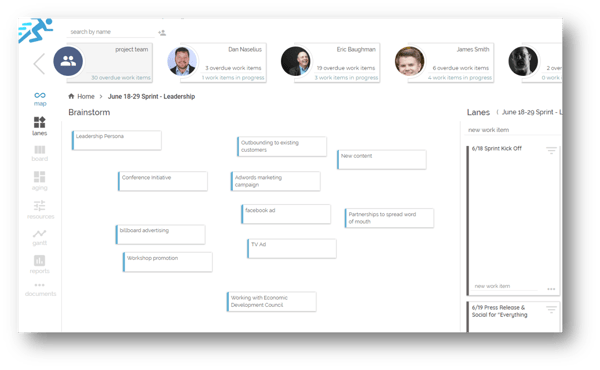This is a follow-up to my previous article on running an agile customer success, sales, and marketing team. For the original, click here. You don't necessarily have to read both, but I believe it helps provide some context for what we are talking about, and why we are solving this problem.
In this article, I am going to focus more on the method, and some basic tips, tricks, and tools you can use. I'll include a couple of screenshots of how we accomplish this internally. This is not intended to be a product pitch (although I certainly won't stop you if you want to try it or buy it), this is just the tool we happen to use internally. Now that I've got the disclaimer out of the way, we can get started.
The first and most important thing you need to do is define your strategic objectives. If you don't have these clearly defined, you are doomed before you start.
The first and most important thing you need to do is define your strategic objectives. If you don't have these clearly defined, you are doomed before you start. Everything that follows, should be in the service of driving one of those objectives forward. Without the end result in mind, you can quickly find yourself in a place where all the teams are busy, stretched thin, and doing work that does not actually add value to the organization. If your strategic goals are already defined, all the members of your teams know what they are, and understand how what they are doing relates back to them, Congratulations! If you are like most people, this doesn't describe your organization. The first step then is to get together and strategize. Pick the 3-5 best high-level objectives and plant your flag. Don't do more than 5 - adding more objectives is going to create serious competition for mind space and will hurt your chances of keeping the organization aligned. Some examples could be: Increase customer satisfaction, Improve operational efficiency, Improve brand awareness, etc.
Once you have your objectives, it's time to brainstorm some ways to achieve an objective. The way we do this at CORAS is we have a collaborative meeting with Sales, Marketing, and Customer Success. All the different members of the teams enter their ideas into an unstructured list (which we conveniently call the Brainstorm) - the beauty of this is that you can engage multiple roles and levels within your organization at the same time. The principles behind this are 1) a good idea can come from anywhere and 2) the "boots on the ground" have superior insight into work execution because they are the fewest degrees removed from it. You could also use a whiteboard and jot down all the ideas there, but ultimately we've found that fewer ideas get captured there and you can't engage as many team members. Whiteboards typically (though not always) have to go through a mediator because of the simple economics of not having enough space for everyone to crowd around and write. This means not everyone fully participates, and therefore fewer ideas get to percolate.
 Image 1: Brainstorming
Image 1: Brainstorming
The principles behind this are 1) a good idea can come from anywhere and 2) the "boots on the ground" have superior insight into work execution because they are the fewest degrees removed from it.
Once you've picked which of the ideas best advance your objective, now it's time to get a cross-functional team together to execute the vision. It is important to get all the members of the execution team together to brainstorm out all the different tasks and to do's in order to complete the initiative. I'll give you another internal example of this - after a brainstorming session around how to advance our company's brand awareness, one of the ideas we came up with was sponsoring events that aligned with our core messaging and giving the conference attendees access to our software. We pulled together a small team with members from marketing, sales, customer success, and thought through everything we might need to pull off this initiative. We determined there needed to be an outbound effort from sales, marketing collateral needed to be created, and a customer success workflow for the event needed to be created and implemented (this was just part of it, the real list was much, much longer).
We organized all the work into 2-week sprints and assigned various tasks to the relevant members of the team. During the sprint, we had a morning stand-up meeting, and an evening cool-down meeting, each about 15 minutes. The primary goals of these meetings are to keep people on task and to learn from each other during the initiative. As sales gather data on the front lines, they can relay it right back to marketing and CS as things are happening. The team in charge of the initiative can quickly make course corrections or adapt on the fly, without going through a lengthy approval process back to the Executive level. The ultimate goal of getting your team to work in this manner is to close the feedback loop between trying, learning, and adjusting, thereby shortening the path to business value. Doing this will accelerate your ability to achieve results. This allows everyone to see the full body of work, who is doing what, when they are doing it, and what still needs to get done before the initiative completes. It eliminates a lot of the finger-pointing dynamic that is typical of Funnel Vision organizations.
 Image 2: Sprint
Image 2: Sprint
The ultimate goal of getting your team to work in this manner is to close the feedback loop between trying, learning, and adjusting, thereby shortening the path to business value.
This is just one specific example, but you can apply these principles broadly to any initiative. The key is to have teams be large enough that they can handle the body of work in the allotted time but small enough that they don't run into issues communicating and learning from each other. If you're uncertain where to apply this in your organization, think of the last initiative your company tried. At any point, were you waiting on another team to do something, and didn't know when they were going to deliver it? Did your sales team try messaging during a call blitz that failed miserably, but marketing continued to run advertising with that messaging? You're not alone - this is the rule rather than the exception. If this describes you, give some of the principles in this blog a try. You might surprise yourself with the results!